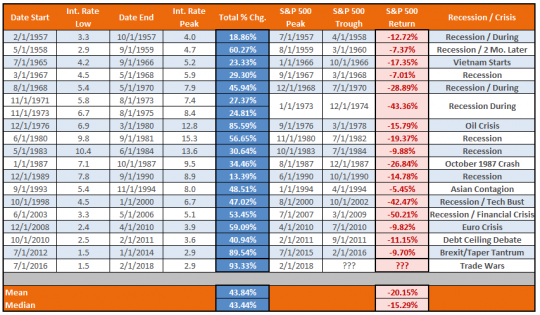18 Times The Fed Has Gone Through A Rate Hiking Cycle, And 18 Times It Has Caused A Huge Stock Market Decline And/Or A Recession
 Since 1913, the Federal Reserve has engaged in 18 distinct interest rate hiking campaigns, and in every single one of those instances the end result was a large stock market decline, a recession, or both. Now we are in the 19th rate tightening cycle since 1913, but many of the experts are insisting that things will somehow be different this time. They assure us that the U.S. economy will continue to grow and that stock prices will continue to soar. Of course the truth is that if something happens 18 times in a row, there is a really, really good chance that it will happen on the 19th time too. For years I have been trying to get people to understand that our country has been on an endless roller coaster ride ever since the Fed was created back in 1913. Things can seem quite pleasant when the economy is on one of the upswings, but the downswings can be extremely painful.
Since 1913, the Federal Reserve has engaged in 18 distinct interest rate hiking campaigns, and in every single one of those instances the end result was a large stock market decline, a recession, or both. Now we are in the 19th rate tightening cycle since 1913, but many of the experts are insisting that things will somehow be different this time. They assure us that the U.S. economy will continue to grow and that stock prices will continue to soar. Of course the truth is that if something happens 18 times in a row, there is a really, really good chance that it will happen on the 19th time too. For years I have been trying to get people to understand that our country has been on an endless roller coaster ride ever since the Fed was created back in 1913. Things can seem quite pleasant when the economy is on one of the upswings, but the downswings can be extremely painful.
It was economist Lance Roberts that pointed out this correlation between rate hiking cycles and economic troubles. When I came across his most recent article, it really got my attention…
A sustained interest rate hiking campaign, as undertaken by the Fed, has always resulted in negative stock market returns.
Always. Not usually, not might-be-correlated-to. Always. As in, 18 out of 18 times. Until now. When we’ve had the single highest percentage increase in history (93.33% peak to trough, so far).
To support his claims, he posted this chart…
So far, however, there hasn’t been a huge stock market drop or a recession during this rate hiking cycle.
Has something changed?
Is the 19th time going to be fundamentally different?
…click on the above link to read the rest of the article…